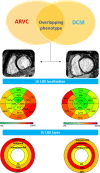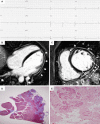Arrhythmogenic Right Ventricular Cardiomyopathy: Characterization of Left Ventricular Phenotype and Differential Diagnosis With Dilated Cardiomyopathy
- PMID: 32114891
- PMCID: PMC7335583
- DOI: 10.1161/JAHA.119.014628
Arrhythmogenic Right Ventricular Cardiomyopathy: Characterization of Left Ventricular Phenotype and Differential Diagnosis With Dilated Cardiomyopathy
Abstract
Background This study assessed the prevalence of left ventricular (LV) involvement and characterized the clinical, electrocardiographic, and imaging features of LV phenotype in patients with arrhythmogenic right ventricular cardiomyopathy (ARVC). Differential diagnosis between ARVC-LV phenotype and dilated cardiomyopathy (DCM) was evaluated. Methods and Results The study population included 87 ARVC patients (median age 34 years) and 153 DCM patients (median age 51 years). All underwent cardiac magnetic resonance with quantitative tissue characterization. Fifty-eight ARVC patients (67%) had LV involvement, with both LV systolic dysfunction and LV late gadolinium enhancement (LGE) in 41/58 (71%) and LV-LGE in isolation in 17 (29%). Compared with DCM, the ARVC-LV phenotype was statistically significantly more often characterized by low QRS voltages in limb leads, T-wave inversion in the inferolateral leads and major ventricular arrhythmias. LV-LGE was found in all ARVC patients with LV systolic dysfunction and in 69/153 (45%) of DCM patients. Patients with ARVC and LV systolic dysfunction had a greater amount of LV-LGE (25% versus 13% of LV mass; P<0.01), mostly localized in the subepicardial LV wall layers. An LV-LGE ≥20% had a 100% specificity for diagnosis of ARVC-LV phenotype. An inverse correlation between LV ejection fraction and LV-LGE extent was found in the ARVC-LV phenotype (r=-0.63; P<0.01), but not in DCM (r=-0.01; P=0.94). Conclusions LV involvement in ARVC is common and characterized by clinical and cardiac magnetic resonance features which differ from those seen in DCM. The most distinctive feature of ARVC-LV phenotype is the large amount of LV-LGE/fibrosis, which impacts directly and negatively on the LV systolic function.
Keywords: arrhythmogenic right ventricular cardiomyopathy; cardiac magnetic resonance; dilated cardiomyopathy; late gadolinium enhancement; left ventricular involvement; left ventricular phenotype.
Figures






References
-
- Marcus FI, Fontaine GH, Guiraudon G, Frank R, Laurenceau JL, Malergue C, Grosgogeat Y. Right ventricular dysplasia: a report of 24 adult cases. Circulation. 1982;65:384–398. - PubMed
-
- Thiene G, Nava A, Corrado D, Rossi L, Pennelli N. Right ventricular cardiomyopathy and sudden death in young people. N Engl J Med. 1988;318:129–133. - PubMed
-
- Basso C, Thiene G, Corrado D, Angelini A, Nava A, Valente M. Arrhythmogenic right ventricular cardiomyopathy. Dysplasia, dystrophy, or myocarditis? Circulation. 1996;94:983–991. - PubMed
-
- Corrado D, Basso C, Thiene G, McKenna WJ, Davies MJ, Fontaliran F, Nava A, Silvestri F, Blomstrom‐Lundqvist C, Wlodarska EK, Fontaine G, Camerini F. Spectrum of clinicopathologic manifestations of arrhythmogenic right ventricular cardiomyopathy/dysplasia: a multicenter study. J Am Coll Cardiol. 1997;30:1512–1520. - PubMed
-
- Sen‐Chowdhry S, Syrris P, Prasad SK, Hughes SE, Merrifield R, Ward D, Pennell DJ, McKenna WJ. Left‐dominant arrhythmogenic cardiomyopathy: an under‐recognized clinical entity. J Am Coll Cardiol. 2008;52:2175–2187. - PubMed
Publication types
MeSH terms
Substances
LinkOut - more resources
Full Text Sources

